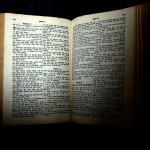1. Most scholars don’t believe that Moses wrote the five books of Moses. Moses never claims to have written them (within the text) and there are things that happen in them that Moses couldn’t have written (his death being the most important of these). So, they don’t call them the Five Books of Moses. Instead, most Christian scholars call these books the Pentateuch (greek for “five books”) and most Jewish Scholars call these books the Torah (Hebrew for “instruction”). People who don’t feel like injecting religious belief into this pick and choose.
2. Instead, most Biblical scholars adopt some form of the so-called Documentary Hypothesis. This hypothesis argues that the Pentateuch, as we have it, is formed from weaving together several different sources together into one roughly harmonized whole. In its most common form (as delineated by Julius Wellhausen), there are four source documents, known as J, E, P, and D. The strongest arguments for the existence of these sources are the several repeated stories in the book of Genesis. In some cases (the creation, the flood), two complete and separate stories can be convincingly unbound from one another. There are also arguments from vocabulary (different sources use different vocabularies) but these tend to be weaker.
3. The J source is named after the name it consistently uses for God, which is YHWH (probably pronounced Yahweh). The German would be Jahweh, hence the J. The J source appears to be the earliest of the sources, with many scholars dating it to the era of the Davidic or Solomonic kingdom. They do this because J, amongst other things, argues for the legitimacy of the Davidic dynasty. Generally speaking, the J source is less xenophobic than the other sources and women feature more prominently.
4. The E source is also named after the name that it uses for God. Prior to the revelation of God’s name to Moses in Exodus 3, the E source refers to him as Elohim (Hebrew for God). After Exodus 3, the E source refers to him as YHWH. The E source is generally dated to a roughly similar era as the J source, but, rather than representing the Davidic dynasty and its priesthood, it is thought to represent the viewpoint of another group of priests, perhaps descended from Moses, who originated in the Northern Kingdom. Aaron’s involvement in the incident of the golden calf and his general weakness are both ideas that come from E documents. So, the E source, amongst other concerns, may want to express the illegitimacy of the currently ruling party of priests.
5. The D source is present primarily in the book of Deuteronomy (which is where the D comes from). D is generally dated to the era of Josiah, because the Josianic reforms often mimic the law as revealed in Deuteronomy. Further, the Deuteronomistic history (comprising Joshua-Kings) appears to be a court history developed at the beginning of Josiah’s reign (with some material obviously added after his death). That said, the relationship between the D source and the Deuteronomistic history (chronologically and otherwise) remains unclear. The D source is particularly interested in the notion of covenant and features a lengthy discussion of Israel’s covenant with God, which ultimately becomes the justification for God’s abandoning them to Babylon in the time of Zedekiah.
6. The P source is the largest and, in some ways, the most hotly disputed. It contains almost all of the non-Deuteronomic legal and sacrificial material. Generally it is concerned with the maintenance of religious boundaries and it describes its narratives with more precision than the other sources. The P source appears to borrow vocabulary and some narratives from Mesopotamian sources, so most scholars date it to the era of the Babylonian captivity. However, there is a small and growing movement that dates it to the reign of Hezekiah.
7. Having said that most scholars accept a version of the documentary hypothesis, it is also accurate to say that most scholars dislike it. In the form Wellhausen gave it, its conclusions about dating relied too much on Hegelian models of religious development that have since been shown to be misguided. For that matter, the original formulation assumed four actual documents that were harmonized by an editor (R or “the redactor”). Scholars today talk of schools of scribes, rather than individual documents, although there is only circumstantial evidence for this. Other scholars still believe in layers of redaction, but they don’t use the layers Wellhausen delineated. Many scholars feel that the speculative nature of all these assumptions mean that the entire theory is too untrustworthy to be the basis of history.
8. Whatever the speculative nature of the sources, most scholars identify the 5th century as the period when the Pentateuch was blended together into its current form. The identification of the scribe Ezra as a culture hero from this period helps. The Persians supported the religious movements of their subjects and we have artifacts that indicate the they treated other religions in a manner similar to their Biblical treatment of the Hebrews. It is, perhaps, for this reason that Cyrus is referred to as a Savior in 2nd Isaiah. In any case, the Persians appear to have been willing to provide material support for religious scribal activity. The biblical record indicates that the return to Israel was a period of identity crisis for the Israelites. Therefore, the creation of a document like the Pentateuch, which offers culture history, ritual, and boundary maintenance, seems reasonable in this era.
9. Therefore, some scholars suggest that we must understand the entire Pentateuch in a 5th century context. If there is no firm proof that any particular passage predates the 5th century, it could be thought that using it to date and confirm events prior to that era is irresponsible. Other scholars go further and argue that, since the earliest other versions of the Pentateuch (like the Dead Sea Scrolls or the Septuagint) seem to date to the 3rd century BCE, there is no reason to date anything in the Pentateuch prior to that period.
10. However, there are some passages within the Pentateuch that appear to have linguistic characteristics in common with the oldest Hebrew artifacts that we have found. For instance the Song of Moses in Exodus 15, the blessing of Jacob in Genesis 49, and the oracles of Balaam in Numbers 22-23 may all be much older than the 5th century (some see a couple as dating back to the earliest arrival of the Israelites in the 11th and 12th centuries BCE). Therefore, it is likely that, although the Pentateuch was composed in the 5th century, there is much material that is older than that. The problem is figuring out what goes when, what constitutes sufficient evidence, and what the significance of the passage is within its proposed original context.











